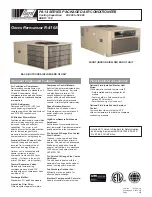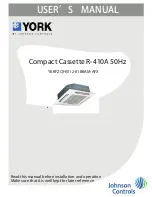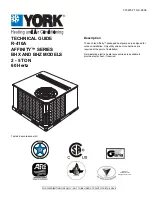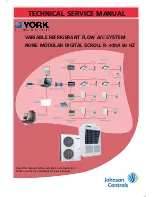
6-1
DIAGNOSIS & TROUBLESHOOTING
DIAGNOSING THE SEALED SYSTEM
REFRIGERANT CHARGING
The proper refrigerant charge is essential to
proper sealed system operation. Operating the
unit with an improper refrigerant charge will
result in reduced performance and efficiency.
The use of proper charging methods during
servicing will insure that the unit is functioning
as designed, and that its compressor will not be
damaged.
Too much (overcharged) or too little (under-
charged) refrigerant in the system can be the
source of compressor failure if uncorrected for
any period of time.
An
overcharged
system will sometimes return
liquid refrigerant back to the suction side of the
compressor, and eventually cause a mechani-
cal failure within the compressor. This me-
chanical failure can manifest itself as valve
failure, bearing failure, or some other mechani-
cal failure. The specific type of failure will be
influenced by the amount of liquid being re-
turned to the suction line, and the length of time
that it continues.
An
undercharged
system will cause the tem-
perature of the suction gas to increase to the
point where it does not provide sufficient cool-
ing for the compressor motor. When this oc-
curs, the motor winding temperature will in-
crease, causing the motor to overheat, and
open the compressor’s overload protector. Con-
tinued overheating of the motor windings and
cycling of the overload, will eventually lead to
compressor motor, or overload failure.
METHOD OF CHARGING
The preferred and most accurate method for
charging the PTAC system is called the
“Weighed in Charge Method,” and is appli-
cable to all units. This method should always
be used whenever a charge is removed from a
unit for a leak repair, compressor replacement,
or when there is no refrigerant charge left in the
unit.
To use this method, perform the following
steps:
1. Install a piercing valve to remove refriger-
ant from the sealed system.
NOTE:
The
piercing valve must be removed from the
system before recharging.
2. Recover the refrigerant in accordance with
EPA regulations.
3. Install a process tube to the sealed system.
4. Make the necessary repairs to the system.
5. Evacuate the system to 300 microns or
less.
6. Weigh in the refrigerant with the proper
quantity of R-22 refrigerant.
7. Start the unit, and verify its performance.
8. Crimp the process tube closed, and solder
the end shut.
Summary of Contents for ATE0743RPP
Page 20: ...2 12 NOTES ...
Page 30: ...3 10 NOTES ...
Page 71: ...7 5 WIRING DIAGRAMS DIAGRAM 1 ...
Page 72: ...7 6 DIAGRAM 3 DIAGRAM 2 ...
Page 73: ...7 7 DIAGRAM 4 DIAGRAM 5 ...
Page 74: ...7 8 DIAGRAM 7 DIAGRAM 6 ...
Page 75: ...7 9 DIAGRAM 8 ...
Page 84: ...7 18 NOTES ...
Page 90: ...8 6 NOTES ...
Page 92: ...CORPORATION ...
















































